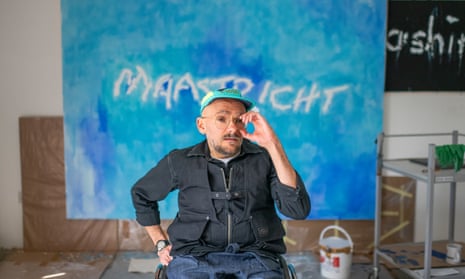The real killer of art, Ryan Gander suggests, is procrastination. His solution is always to act on ideas “before they lose their energy”. His studio, in a former register office and sports hall in the Suffolk village of Melton, is living proof of that determination. Before we sit and talk, he gives me a tour.
In one room are the moon paintings he is making for an exhibition in Tokyo, some using paint prints from upturned tables in a Chinese restaurant; in another are some of his draped mirror series in which the reflection-obscuring fabric is cast in marble; here are piles of art posters for exhibitions that never happened, there are animatronic “dying mosquitoes” twitching on gold playing cards; in one corner is a vending machine trading an alphabetic list of “everything you never want to run out of” – A is After Eights, B is Beer, # is a bag of marijuana; there are recreations of graffitied back alley doorways, recast in polished steel; plans for the most authentic lifesize gorilla robot ever made, with “smells, sounds, everything”, which should be ready for his exhibition at Lisson Gallery later this year; homages to 1970s slideshows; a recreated transparent Japanese gym locker…
Gander has always been a one-man group show. For a start, he has a small team of assistants making and planning; for another thing he’s got eight artistic alter egos, who have created different strands of his work for more than 15 years. The fictional artist selves, he says, allow him “to make work better than I can make work, but also work that’s more superficial and shallow than I would want to make”. The tackiest of them is Santo Sterne and the most high-minded is Santo’s anagram Aston Ernest.
Gander, as you’ll have gathered, is a conceptual artist, but he is also a likeable kind of philosopher, providing ad hoc theories to order. My favourite piece of his is The End (2020), in which an animatronic mouse appeared through a hole at the bottom of the wall of an empty gallery room to talk about metaphysics (in the voice of Gander’s nine-year-old daughter Olive). Gander’s practice includes the ongoing lecture series Loose Associations, in which he riffs on ideas that interest him. He has never been afraid of risk. For the Documenta 13 show in Germany in 2012, he exhibited a cool breeze circulating in an empty gallery.
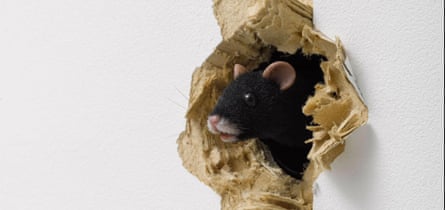
We end up in his office – “I don’t work in here that often,” he says, “because I get lonely” – which has a couple of hundred printed notes pinned to the wall, as three-word “catalyst ideas” for future projects: “cartoon, poster, wobble”, say. “You won’t know what that means,” Gander says, “but I do.” The hope is that the cards start to make connections with each other, like a mind map, or a police investigation wall. There are also shelves of file boxes marked: “chronos” and “kairos”, two ancient Greek words for different aspects of time. “Chronos is what I would make if I had more time and money,” Gander says, explaining his system. “Kairos is more like ‘readiness’, for now. Like my son, Baxter, is three and he is autistic. You can’t say to him ‘wait until six o’clock to eat’. He has to eat when he is hungry. That’s kairos.” He pulls out a bunch of bundled photographs: “Baxter’s lines,” he says. “My son is quite compulsive and he puts all his toys and cars and stuff in long lines across the floor. I’ve been recording them in pictures, and I’ll probably recreate them in a gallery at some point.”
Does he get haunted by the ideas he hasn’t made yet?
“No,” he says, “just by never having enough resources or time.”
The particular project I’m here to talk about is Gander’s gift to the people of Manchester for the forthcoming international festival. Gander grew up in the north-west and spent five years as an adult living in Salford. “My wife always says that I turn into someone different when I’m there – I scowl more,” he says, with a grin.
The project for the festival – which he will headline alongside the Japanese artist Yayoi Kusama and her famous infinity rooms – is a series of three coins, tens of thousands of which are currently being minted. The final number will depend on the “cost of the metals and the exchange rates”, but the plan is to produce about 250,000, one for every other person in the city. On each day of the festival, Gander’s coins will be scattered around the city on park benches and library shelves and tram seats and pavements, “a bit like a massive treasure hunt”.
Each coin shows a version of heads and tails, and they all relate, the artist says, to “values that we maybe don’t think about often enough”. The idea is people might pick one up, a little piece of art, and feel lucky to have found it. “They might put it in their pocket as a decision-making tool. It is a currency, but it’s a currency of happenstance.”
He picks up a coin from the box in front of him, turns it over to the light. “This one is ‘listen/speak’,” he says. “On the listen side, it says: ‘Your silence is louder than their raised voice.’” Speak says: ‘Panoramic voice, panoramic vision.’” He picks up a second coin; this one is ‘pause/action’. The quotes here are two things his father – “the wisest man I know” – said to him as a kid. On one side: “Time is your greatest asset.” On the other, “the most useful quote ever: ‘Let the world take a turn’… My dad always used to say that if I was angry or frustrated. Things will look different tomorrow. He was a Stoic, without realising it.”
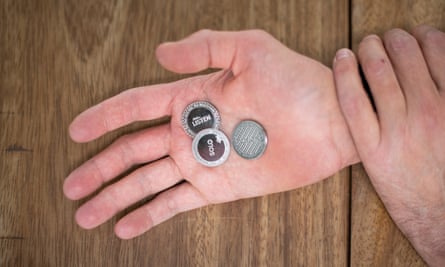
In the course of talking about his art, Gander talks quite a lot about his father. Gander grew up in Chester, where his dad worked as an engineer at the Vauxhall factory in Ellesmere Port and his mum was a teacher and then a school inspector. There wasn’t a lot of art around at home, he said, but his dad wrote good poetry. Before Ryan was born his parents had lived in California for a while, where Ian Gander was posted with General Motors. He brought a little of the summer of love back to 1970s Cheshire: “he came back with a fur coat, smoking Gauloises”, and with a belief that the world was full of possibility. He conveyed that to his son.
Gander picks up the third coin. This one is “solo/together”. On one side it advises: “Know your place in the world is not fixed.” On the other, a quote from the artist Carmen Herrera: “Tend to curiosities beyond your own identity.” That latter motto sounds like the closest to a personal statement for Gander. Before I’d met him, I’d been advised that he had no wish at all to talk about, or be defined by, using a wheelchair (he was born with a severe brittle bone condition).
He raises that idea, in relation to the Herrera quote. “The art world these days has a lot of artists who barter in unique selling points,” he says. “But I don’t identify with being in a wheelchair at all. As far as I’m concerned, I’m not disabled – I’ve spent my whole life trying not to be disabled. It’s not something I want to embrace. Like anyone, there are some things I can’t do and some things I can do. And that’s the end of it.”
Looking back, he suggests, if his condition had any effect on him, the fact that he spent half his childhood in hospital with broken bones meant he was “socialised with adults, not children”.
“In hospital you can’t physically play or experience things,” he says, “you can’t go to places, so I suppose you gain a sort of overactive imagination. And it’s like any muscle, isn’t it? I think my imagination was severely overworked in hospital because I had a fixed perspective on the world. So I had to imagine things. That’s what I think going to a gallery or museum is like; it’s like taking your imagination to the gym, just for a workout, to keep it active.”
Does that help to explain his creation of artistic alter egos?

“I don’t do autobiography a lot. But yeah. The alter ego thing is probably that idea of prototyping experiences. And for me, life is one massive prototyping experience.”
That mind-wandering, these days, has a large physical component. As well as exhibiting across the world, Gander has recently produced public art works in Central Park, New York, and Mexico City Zoo among other places. He has been a visiting lecturer at the Royal College of Art in London, as well as the University of Southern California and Fudan University in Shanghai. He is a Royal Academician and an OBE. Is there a sort of pinch-yourself feeling, I wonder, in this dreamt-of life that has come true?
“I come here at night sometimes on my own, and I can’t believe it,” he says, of his sprawling ideas complex. “It’s like an art school and it’s all just for me.”
His work ethic comes in part from a knowledge of the alternatives. “I always like to feel as though I’m doing a real job,” he says. When he first left Manchester Metropolitan University in 1999, he worked in a carpet shop. And then as a not very successful trainee at a newspaper in north Wales. “A lot of artists make art to please themselves,” he says. “But my work ethic and my guilt about how lucky I am won’t let me do that. I don’t make art to enjoy it. I do it to discover stuff. Art has to be a bit mad,” he says. “Why would I just make one thing for 30 or 40 years in different sizes and different colours? That doesn’t make any sense to me.”
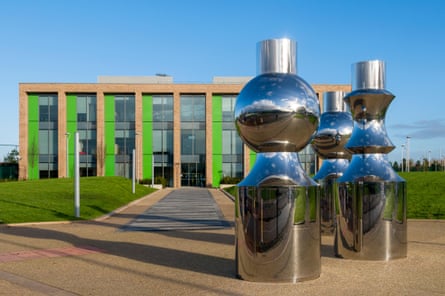
Does that absence of a signature idea make him an art dealer’s headache? “Yeah, I mean, in terms of selling art I think that’s probably my biggest downfall.”
Gander has cared less about that world since he moved out of London with his wife Rebecca May Marston, former director of the Limoncello Gallery, about 14 years ago. They live not far from the studio in the town of Saxmundham with their three kids, in a magical house he has designed in a converted Victorian school. What they have bought there as well as space, Gander says – they used to live in a flat next to a strip club in Hackney – is time. “Up here, you notice people from London because they walk a bit quicker. But life literally lasts longer here. When I was in London I used to wheel myself around really quickly because it felt like that was what you did if you were ambitious,” he says. “Here I take time to go the wrong way, and get lost. Though of course people still look at me anxiously: ‘You don’t live in London – where do you get coffee?’”
The rural regime has also, he suggests, allowed him to avoid a midlife crisis – he’s 47 – “though people keep saying to me: ‘You are making all this work about time and about value – are you OK?’” The fact is, he says, he’s never stopped thinking about those questions.
“One of my kids, the other night was doing the thing that all kids do at some point: ‘I’m going to die,’” he says. “I sat with her and explained some of the ideas of Shintoism to her, and how all things were collections of molecules and they didn’t die, they formed themselves into other things. Because when I was a kid and I had that feeling, I convinced myself of reincarnation, and it suppressed the worry.”
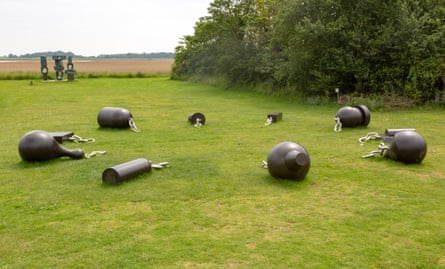
Did it work for his daughter?
He smiles. “She sat there for a while and was like: ‘I don’t know if I believe in that.’ But it distracted her for a bit.”
The abiding antidote to those thoughts is creativity, Gander suggests; it’s what always keeps him going. “No artist is supposed to admit it,” he says, “but I’m both really ambitious and really jealous. I think jealousy can be really healthy. I think some of the best works I’ve made have come out of sitting in a pub next to another artist and she’s gone: ‘I’m doing this.’ And I’m like: ‘Oh, shit, that’s so good.’ And I’ll be rushing back to the studio.”
How does he measure the quality of one idea over another?
“By its life,” he says. “I don’t mean the life of the object, I mean, the life of the story about it. For me, the only value art has is the conversation we have about it. The value of Cornelia Parker sending a meteorite back into space with Nasa, is not the meteorite, but the fact that maybe someone in a bar in Madrid is telling someone else about it right now. We tend to measure the world in physical, tangible things. And we don’t measure the world in ephemeral things like stories, moments, memories.”
Gander has plenty of plans to create many more of those moments – not least on the streets of Manchester over the summer. But he also knows there will never be enough of them, even with the help of technology.
“There is a work that I am doing at the moment which is a virtual reality goggles thing,” he says. “It’s called Ryan Waiting. You put the goggles on and you are in a white, perimeterless landscape, and I’m already in there, an animation of me. The animation is controlled by an algorithm that will last for 100 years; you might see me looking at my watch, or heading off into the distance, or whatever, I don’t know. I’m in there now, doing something.”
He laughs. The plan is for his ideas never to stop.
